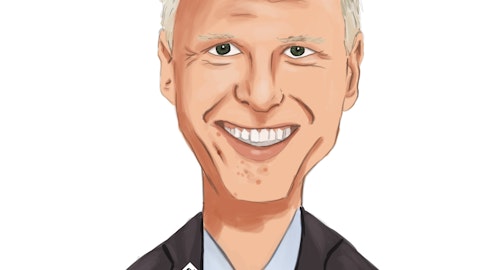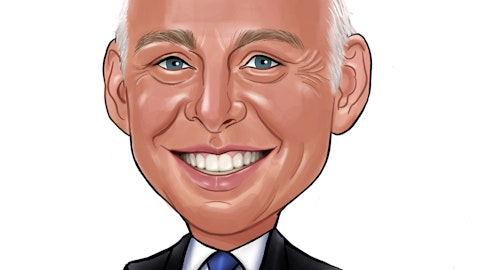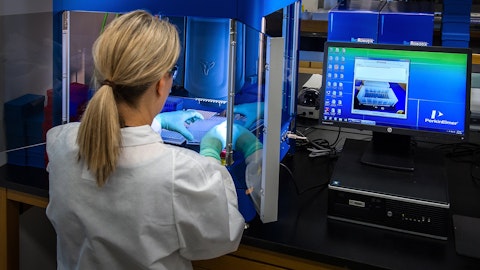Sunny Sanyal: Yes, if you look at our growth in China, that’s been at very high clip 20%, 30%-ish type of growth in terms of the buying. So this month is holiday month in China. There’s New Year, so hard to call it a trend. But in general, we’re not seeing a slowing of government investment. We’re not seeing a slowing in expansion of healthcare. So the question becomes and is it going to continue — how long is it going to continue at 305 pace? That’s the part that I think as we look ahead, we can see a couple of quarters. We can’t see beyond that, but we’re just putting it in that same bucket of the softening to same. If the trends are probably global trends, so — but CT continues to be strong and right behind CT in China is cardiovascular and oncology. Those are the newer modalities that are starting to pop up. So overall, prospects of China for us continue to remain strong.
Larry Solow: Okay. That’s fair. So I mean, just a growing — growth rate. I mean, you can’t grow 30%, 40% forever, I get that. So, but selling is still growing there. And then just clarify the COVID related shutdowns in Q4 or calendar Q4? I know we did then talk from some other manufacturers and stuff that, that normally that quarter is more of accelerated manufacturing and overtime and whatnot because then they know there’s sort of a slowdown in Chinese New Year. So it’s kind of a double whammy. But I feel like you guys haven’t been impacted that much by the COVID shutdown. There is always the CT build out over the last couple of years during — even the heart of COVID. So was that — did that have any play on your results for this quarter or this quarter’s outlook?
Sunny Sanyal: Go ahead, Sam.
Sam Maheshwari: Yes. So Larry, the medical products were exempted all through that process. And so yes, there was somewhat of a disruption, but not major. We continue to produce all through the last many quarters. And so it was neither a big — it was not something that impacted us very much. And so we are not expecting that, that opening up would increase significantly for us either, because it really did not impact us significantly that way. And as I said, our products were exempted and so we’ve been continuing to produce through and ship them.
Sunny Sanyal : And our operations during this time were stable and so with our customers.
Larry Solow: Yes. Right. Okay, if I could just squeeze one more, just to revenue slower, maybe little — it sounds like inflation still hurt you guys in labor costs aren’t fair, but hopefully those are going in the right direction. I’m just trying to set; are there any leverage you can pull? Or you guys done a good job last couple of years sort of keeping costs down and where you can in a tough environment. So if revenues outlook is a little slower, can you — is there any offsets maybe over the next few quarters you could or you sort of just not much you could do on that side?
Sam Maheshwari: Yes, so I think there are certain levers, but there is always a timeline associated with those levers, Larry. So what’s happening is that the price cost drag on the P&L, cost increase happens sooner than price improvements get realized on the P&L, that’s the price cost drag. That’s kind of hurting us about 200 basis points right now. And in the December quarter, freight was high. Freight is beginning to improve as we speak since January. So that was a drag of about 100 basis points on our gross margin. So hopefully in couple of months, freight begins to improve. And we talked about mix, and I’m hoping mix is a shorter-term phenomenon and maybe it impacts us in the first half and gets to improve from the second half onwards.
We — mix is very difficult to predict or difficult to control, but that is how I’m thinking. Mix is impacting about 100 basis points. So overall in terms of us improving our gross margins and us improving our financials, we are laser focused on improving manufacturing efficiencies and that supply chain pressure get eased a little bit and they are, they have been improving steadily now for a few months. So as that gets eased, our manufacturing efficiency should come back into play. And so the volume, we are still expecting flat to slightly up as we said in our prepared remarks. So it is still a positive for us, but maybe not as much as we thought about it three or four months ago, but we — the offsets would be manufacturing efficiencies hopefully mix comes back.
And I’m thinking as a few quarters go by, the price cause drag that gets more in shape. And then finally, in our inventory, we have some high-priced semiconductor chips in our inventory that will roll through. So my thinking is by the end of calendar year, the price cost drag and the high margin — high-cost chips have rolled through the inventory and that’s how I’m looking at it.
Larry Solow: Okay. And I appreciate that color. That’s great. Thanks again, guys.
Sunny Sanyal: Thank you.
Operator: Thank you. Our next question is from Suraj Kalia with Oppenheimer. Please proceed with your question
Suraj Kalia: Sunny, Sam, can you hear me alright?
Sunny Sanyal: Yes, we can, Suraj. How are you?
Suraj Kalia: Hope you guys are well. So Sunny, Sam, obviously you guys made a lot of commentary about forward-looking outlook. Sunny, maybe specifically, I want to compare and contrast, if I could. So if you look at the commentary from GE Healthcare, right, they presented quite a bullish outlook in terms of cash spend, imaging and sound across the spectrum. And if I remember correctly, there wasn’t that level of caution. You guys have a relatively sort of forward-looking contracts, a significant portion of your revenues are recurring help us reconcile? On one hand, there is caution and from you guys, but on the other hand, some of the bigger players are — its guns blazing. What are we missing in this picture?
Sunny Sanyal: I’ll get started and I’ll ask Sam to add more color. Our OEMs their schedule and of where they are with their orders and order — their cycles of order to delivery versus ours are slightly different, right? So the OEMs had a strong bookings quarter, let’s say, last couple of quarters. And if they’re sitting on inventory right now of stuff that they haven’t shipped yet, haven’t been able to ship yet, that includes our components. So our current quarter is — might be — is softer and slower because their output is slower, it has already has our stuff in it. Then as that moves — as that whip moves through the system, then we would expect certain amount of order input, progress, call offs for us than in the future quarters.
So as we sit in Q2, we’re expecting that softness, because I think our OEMs are sitting in that position of working through their whips. And so as then — as that whip clears, as time goes by, I think then we end up progressing through the year. So with that in mind, we’re looking at our run rates of revenues and that’s why as we did all the math, we’re saying this is likely to be more like flattish to up versus growth, because it starts to then bunch up towards the second half. And then as we look at recessionary environment and what we’re hearing from — also from customers is that they’re having trouble scheduling delivery of some of the larger modality products. The smaller products are going in between, sort of, the capital budgeting process and are making their way into the hands of the customers.
But anything that requires facility modification is getting scheduled out further out, because of CapEx squeeze and other variety of different competing priorities at our — their customers. So with all that and we try to paint a picture for ourselves of what does we only get visibility so much visibility, two quarters worth. But this is as we look further out, we’re trying to paint this picture and hence our cautionary note.
Sam Maheshwari: I think Suraj, I would also like to add here is that my understanding or belief is that hospitals are carrying six to nine to 12 — not hospitals, sorry, our customers are carrying six to nine to 12 months of backlog, whereas we are carrying four to six months of backlog. So the backlog is the buffer that enables our customers to kind of ship through to their customers. Whereas us with less than two quarters of backlog, we see it a bit sooner. That would be one way to also think about the difference between us and our customers.
Suraj Kalia: Got it. And Sam specifically for you, I’ll hop back into queue after this. You made some comments in terms of the gross margins. Obviously, they came a little softer than our expectations. Maybe I missed it, Sam. Was there any shift in customer credit terms, DSOs, any additional line-item color would be greatly appreciated. Gentlemen, thank you for taking my questions.
Sam Maheshwari: Thanks, Suraj. Yes, now there wasn’t really any change in terms of customer credit or DSO. DSO, increased by one or two days, so largely remained flat. I think at this point the credit or customer credit or that type of an issue is not at play here. As I mentioned that the gross margin did come below our expectations, as well and that was mostly around the mix. And mix can change for us and it is also very difficult to get a visibility on for us. So it was really mix that caused the gross margin to come in a bit lower than our expectation. And I’m hoping and we are guiding Q2 with that same somewhat unfavorable mix at this point. But we are thinking mix — if our thinking is right, we believe mix should come back — should improve back again after Q2, that’s what our current thinking is.
Operator: Thank you. Our next question is from Anthony Petrone with Mizuho Group. Please proceed with your question.
Sunny Sanyal: Anthony, we can’t hear you.




